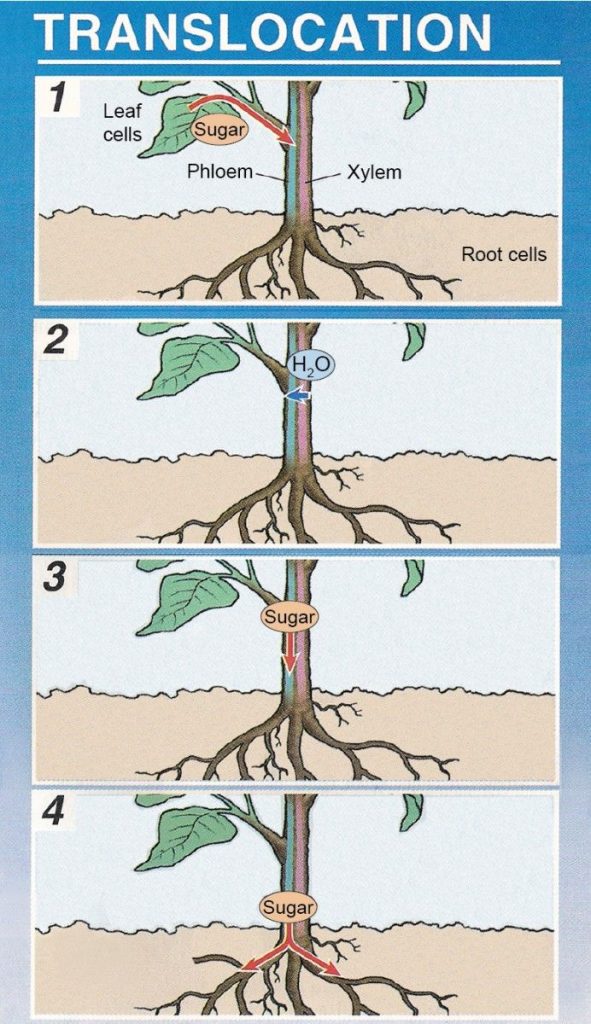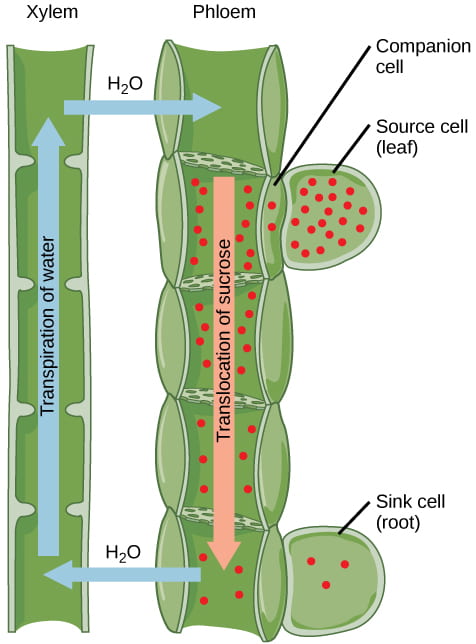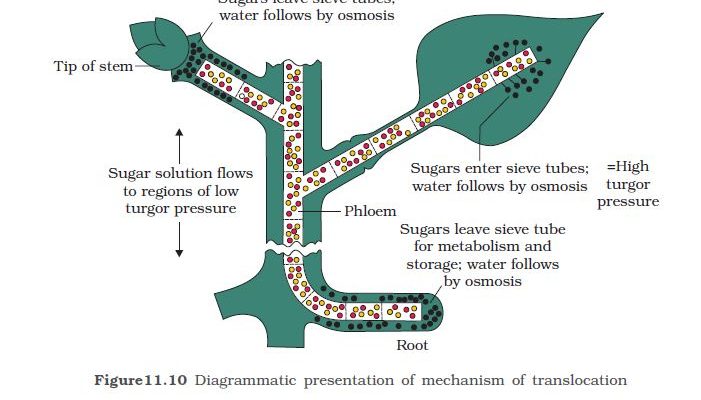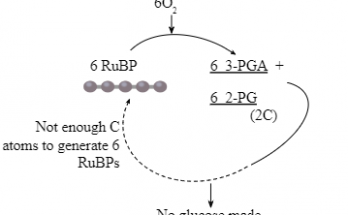Table of Contents
What is Translocation in Plants ?
Leaves make food by the process of photosynthesis.Every part of the plant needs food. So, food made in the leaves of a plant has to be transported to all the parts of the plant like branches, stem and roots, etc.
Transportation of food produced by the process of Photosynthesis from leaves to other parts of plants is called Translocation . In Translocation food produced by the process of photosynthesis is transported from leaves to other parts by using energy derived from ATP.
Also Check – Transportation Class 10th
What are Source Tissue and Sink Tissue in Translocation
In the context of translocation, source tissue and sink tissue in plants refer to the organs or tissues that play a role in the movement of nutrients (such as sugars) from one part of the plant to another.
Source tissue is the tissue where the nutrients are synthesized or stored. In plants the leaves are typically the main source tissue for sugars, which are produced during photosynthesis. Other source tissues include stems, roots and storage organs such as tubers or bulbs.
Sink tissue on the other hand is the tissue where the nutrients are consumed or stored for later use. Examples of sink tissues in plants include the roots, developing fruits, flowers and seeds. Sink tissues have a high demand for nutrients and are thus the sites where the nutrients are transported and accumulated.
The translocation process involves the movement of nutrients from the source tissue to the sink tissue through the phloem, a specialized vascular tissue in plants. This process is essential for the growth and development of the plant as well as the production of fruits and seeds.
Also Check – How is The Food Transported in Plants Class 10
Steps of Translocation in Plants

Translocation in plants is the movement of carbohydrates and other organic compounds from source tissues to sink tissues.
The process of translocation involves several steps which are as follows –
- Carbohydrate loading:
The process of translocation starts with the loading of carbohydrates into the phloem sieve tubes, which are specialized cells that transport sugars throughout the plant. This process occurs in source tissues such as leaves, where photosynthesis produces sugars that are then transported into the phloem.
- Pressure flow
Once loaded, the carbohydrates create a high concentration gradient in the phloem sieve tubes. This high concentration gradient causes water to move into the phloem, creating a pressure gradient that drives the flow of carbohydrates from source tissues to sink tissues.
- Unloading
At the sink tissues, the carbohydrates are unloaded from the phloem sieve tubes and transported to their final destination. This process requires the active transport of sugars from the phloem into the sink cells.
- Storage
Once in the sink tissues, the carbohydrates can be used for growth, energy production, or storage. For example, in root tissues, carbohydrates may be stored as starch for later use.
- Recycling
Finally, some of the carbohydrates may be recycled back to the source tissues for further use. This occurs through the process of retranslocation, in which carbohydrates are transported back to the source tissues for reuse or storage.
Also Check – Transportation in Plants Class 10
Phloem Structure and Function in Translocation
Phloem is a specialized vascular tissue in plants that transports organic compounds such as sugars, amino acids and hormones from the sites of production, usually leaves to the sites of utilization or storage in other parts of the plant.

The phloem tissue is composed of four main types of cells
- Sieve Tube Elements (STE)
- Companion Cells (CC)
- Phloem Parenchyma (PP)
- Phloem Fibers.
Sieve Tube Elements (STE)
- Sieve Tube Elements (STE) are the main conducting cells of phloem and form the tube through which organic compounds are transported.
- They are elongated cells that lack nuclei, ribosomes and most other organelles.
- They contain a cytoplasmic mass and specialized structures called sieve plates.
- The sieve plates are perforated by pores which allow the flow of organic compounds from one STE to another.
Companion Cells (CC)
- Companion cells are specialized cells that are intimately associated with sieve tube elements and play a crucial role in regulating the functions of STEs.
- They have dense cytoplasm, numerous mitochondria and a large nucleus.
- The companion cells are responsible for loading and unloading organic compounds into and out of the sieve tubes.
- They also provide energy to the sieve tubes through the transfer of ATP.
Phloem Parenchyma (PP)
Phloem parenchyma cells are thin-walled and have a large central vacuole.
They are responsible for storing and metabolizing organic compounds.
They also provide structural support to the phloem tissue.
Phloem Fibers.
- Phloem fibers are sclerenchyma cells that provide mechanical support to the phloem tissue.
- They are long and thin cells with thick secondary cell walls that contain lignin.

The process of translocation in phloem involves two main mechanisms
The Pressure flow Hypothesis
- According to the pressure flow hypothesis organic compounds are actively loaded into sieve tube elements in the source tissue (usually leaves) and create a high concentration gradient.
- This gradient generates a pressure gradient that drives the flow of organic compounds from the source tissue to the sink tissue (usually roots, flowers and fruits).
- At the sink tissue, the organic compounds are actively unloaded from the sieve tubes and utilized or stored.
Symplastic Pathway
- The symplastic pathway involves the transport of organic compounds through the plasmodesmata, the cytoplasmic channels that connect adjacent cells.
- In this pathway, the organic compounds move through the cytoplasm of phloem parenchyma cells and sieve tube elements without crossing the cell membrane.
Factors Affecting Translocation In Plants
Factors affecting translocation in plants can be broadly classified into three categories – physical, chemical and biological.
Physical Factors
Physical factors include environmental conditions that can affect the movement of water and nutrients through the plant. These factors are as follows –
- Temperature – Translocation is temperature-dependent, with rates increasing as temperature increases. However, if temperatures get too high or too low, translocation can be disrupted or stopped altogether.
- Light – Light can affect translocation by regulating the production of carbohydrates and other nutrients that are transported through the phloem.
- Water availability – Adequate water availability is necessary for proper translocation, as water is the medium through which nutrients are transported. In drought conditions, translocation can be slowed or halted.
Chemical Factors
Chemical factors that can affect translocation are as follows –
- Hormones – Plant hormones such as auxins, cytokinins and gibberellins can affect translocation by altering the balance between source and sink tissues.
- pH – The pH of the phloem sap can affect translocation by altering the solubility of nutrients in the sap.
- Nutrient availability – The availability of certain nutrients, such as nitrogen and potassium, can affect translocation by altering the concentration gradient between source and sink tissues.
Biological Factors
Biological factors include interactions between the plant and other organisms that can affect translocation. These factors include:
- Insect herbivory – Insect feeding can affect translocation by altering the availability of nutrients or by damaging phloem tissues.
- Fungal infections – Fungal infections can disrupt phloem transport by blocking or damaging phloem tissues.
- Plant-microbe interactions – Certain microbes, such as mycorrhizal fungi, can enhance nutrient uptake and translocation in plants.
Importance of Translocation in Plants
- Nutrient transport – Translocation is the process by which plants transport nutrients, such as sugars, amino acids andminerals, from the leaves (sources) to the rest of the plant (sinks). This is essential for proper growth, development and reproduction as plants require a constant supply of nutrients to function.
- Energy storage – Plants store excess sugars as starch in their leaves during the day and then use this stored energy to support growth and metabolic processes during the night. This is made possible by translocation which moves the excess sugars from the leaves to other parts of the plant for storage.
- Stress responses – Translocation can help plants respond to environmental stresses, such as drought, high temperatures and nutrient deficiencies. By altering the balance of source and sink tissues, plants can redirect nutrients to areas where they are needed most.
- Seed development – During seed development, the mother plant transports nutrients to the developing seeds via the phloem. This is critical for ensuring that the seeds have enough nutrients to germinate and grow into healthy plants.
- Reproduction – In some plant species, translocation is essential for sexual reproduction. For example, in flowering plants, pollen grains are transported via the phloem from the anther to the stigma where they can fertilize the ovules and initiate seed development.
Frequently asked Questions on this Topic
What is Translocation in Plants?
Answer – Translocation is the process of transporting food produced by photosynthesis from leaves to other parts of the plant such as branches, stems and roots etc. using energy derived from ATP.
What are Source Tissue and Sink Tissue in Translocation?
Answer – In translocation, source tissue refers to the tissue where nutrients are synthesised or stored. Leaves are usually the main source tissue for sugars produced during photosynthesis. Sink tissue refers to the tissue where nutrients are consumed or stored for later use. Examples of sink tissues in plants are the roots, developing fruits, flowers and seeds.
What are the Steps of Translocation in Plants?
Answer – The steps of translocation in plants include carbohydrate uptake, pressure flow, unloading, storage and recycling. Carbohydrate loading involves loading carbohydrates into the phloem sieve tubes, followed by the creation of a high concentration gradient that forces water into the phloem and creates a pressure gradient that drives the flow of carbohydrates from the source tissues to the sink tissues. In the sink tissues, the carbohydrates are unloaded from the phloem sieve tubes and transported to their final destination. Once in the sink tissues, the carbohydrates can be used for growth, energy production or storage. Finally, some of the carbohydrates may be returned to the source tissue for further use.
What is Phloem in Translocation?
Answer – The phloem is a specialised vascular tissue in plants that transports organic compounds such as sugars, amino acids and hormones from sites of production, usually the leaves, to sites of use or storage in other parts of the plant.
What are the Elements and Structure of Phloem?
Answer – The phloem tissue consists of four main types of cells: Sieve Tube Elements (STE), Companion Cells (CC), Phloem Parenchyma (PP) and Phloem Fibres. Sieve tube elements (STE) are the main conducting cells of the phloem and form the tube through which organic compounds are transported. Companion Cells (CC) are specialised cells that are closely associated with the sieve tube elements and play a crucial role in regulating the functions of the STEs. Phloem parenchyma cells (PP) are thin-walled and have a large central vacuole. Phloem fibres are sclerenchyma cells that provide mechanical support to the phloem tissue.
Which two mechanisms are involved in the process of translocation in the phloem?
Answer – The two mechanisms involved in the process of translocation in the phloem are the pressure flow hypothesis and Symplastic Pathway.
What is the pressure flow hypothesis?
Answer – According to the pressure flow hypothesis, organic compounds are actively loaded into the sieve tube elements in the parent tissue (usually leaves) and create a high concentration gradient. This gradient creates a pressure gradient that drives the flow of organic compounds from the source tissue to the sink tissue (usually roots, flowers and fruits). In the sink tissue, the organic compounds are actively unloaded from the sieve tubes and utilised or stored.
What is the Symplastic Pathway?
Answer – The Symplastic Pathway involves the transport of organic compounds through plasmodesmata, the cytoplasmic channels that connect neighbouring cells. In this pathway, organic compounds move through the cytoplasm of phloem parenchyma cells and sieve tube elements without crossing the cell membrane.
What physical factors can affect translocation in plants?
Answer – Physical factors that can influence translocation in plants include temperature, light and water availability.
How do hormones affect translocation in plants?
Answer – Plant hormones such as auxins, cytokinins and gibberellins can affect translocation by altering the balance between source and sink tissues.
What is the importance of translocation in plants?
Answer – The importance of translocation in plants includes nutrient transport, energy storage, stress responses, seed development and reproduction.


Good work